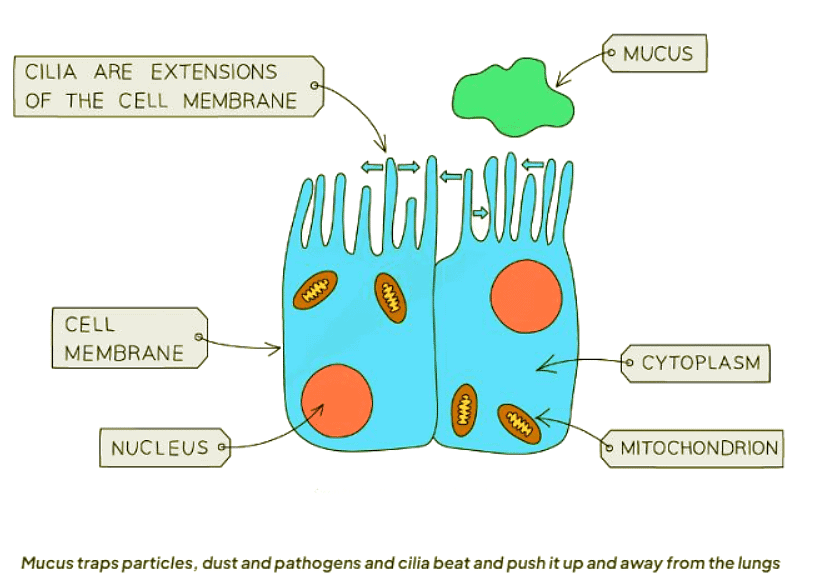Class 10 Exam > Class 10 Notes > Biology for GCSE/IGCSE > Protecting the Breathing System
Protecting the Breathing System | Biology for GCSE/IGCSE - Class 10 PDF Download
Protecting the Breathing System
In this lesson, we delve into the intricate mechanisms that safeguard our breathing system. Let's break down the key points
- Ciliated Epithelial Cells:
- These cells, resembling eyelashes, line the air passages to the lungs.
- Their tiny hair-like structures move mucus upwards, aiding in its removal from the respiratory system.
- Goblet Cells and Mucus Production:
- Goblet cells, shaped like cups, produce the mucus lining.
- Mucus as a Protective Barrier:
- The mucus created traps particles, bacteria, viruses, and dust.
- By doing so, it prevents harmful substances from reaching the lungs, thus safeguarding the lung cells.

Functions of Mucus and Cilia
- The mucus in the respiratory system is secreted by goblet cells and serves to trap bacteria, dust, and other harmful particles.
- Cilia are tiny hair-like structures that beat rhythmically, aiding in the movement of mucus.
- Together, mucus and cilia work to push the trapped particles up and away from the lungs towards the throat for removal.
Question for Protecting the Breathing SystemTry yourself: What is the function of ciliated epithelial cells in the breathing system?View Solution
The document Protecting the Breathing System | Biology for GCSE/IGCSE - Class 10 is a part of the Class 10 Course Biology for GCSE/IGCSE.
All you need of Class 10 at this link: Class 10
|
110 videos|210 docs|33 tests
|
FAQs on Protecting the Breathing System - Biology for GCSE/IGCSE - Class 10
| 1. How can I protect my breathing system from pollutants in the air? |  |
Ans. One way to protect your breathing system from pollutants in the air is by wearing a mask when in highly polluted areas. Additionally, using air purifiers in your home or workplace can help filter out harmful particles in the air.
| 2. What are some common respiratory illnesses that can affect the breathing system? |  |
Ans. Some common respiratory illnesses that can affect the breathing system include asthma, chronic obstructive pulmonary disease (COPD), pneumonia, and bronchitis.
| 3. Is smoking harmful to the breathing system? |  |
Ans. Yes, smoking is extremely harmful to the breathing system. It can cause lung cancer, chronic bronchitis, emphysema, and other serious respiratory diseases.
| 4. How often should I get my breathing system checked by a healthcare professional? |  |
Ans. It is recommended to have regular check-ups with a healthcare professional, especially if you are at risk for respiratory illnesses or have a history of breathing problems. It is important to monitor the health of your breathing system regularly.
| 5. What are some exercises or activities that can help improve lung function and strengthen the breathing system? |  |
Ans. Exercises such as aerobic activities, yoga, and deep breathing exercises can help improve lung function and strengthen the breathing system. These activities can help increase lung capacity and overall respiratory health.
Related Searches















